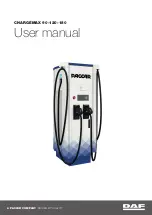
280
Vehicle care
16. Detach the tyre repair kit. Remove
sealant bottle from compressor.
Screw the filler hose to the free
connection of the sealant bottle.
This prevents sealant from
escaping. Stow tyre repair kit in
load compartment.
17. Remove any excess sealant
using a cloth.
18. Continue driving immediately so
that sealant is evenly distributed
in the tyre. Drive between
13 mph and 37 mph. After driving
approx. 3 miles but no more than
ten minutes, stop and check tyre
pressure. Screw compressor air
hose directly onto tyre valve when
doing this. Fill tyre as described
before. Drain excess tyre
pressure with the button on the air
hose.
If tyre pressure hasn't decreased
under 200 kPa (2 bar), set it to the
correct value. Otherwise the
vehicle must not be used. Seek
assistance of a workshop.
Repeat the checking procedure
once more after driving further
6 miles but no more than ten
minutes to check that there is no
more loss of pressure.
If the tyre pressure has fallen
below 200 kPa (2 bar), the vehicle
must not be used. Seek the
assistance of a workshop.
19. Stow away tyre repair kit in load
compartment.
Notice
The driving characteristics of the
repaired tyre are severely affected,
therefore have this tyre replaced.
If unusual noise is heard or the
compressor becomes hot, turn
compressor off for at least 30 min.
The built-in safety valve opens at a
pressure of seven bar (102 psi).
Note the expiry date of the kit. After
this date its sealing capability is no
longer guaranteed. Pay attention to
storage information on sealant
bottle.
Replace the used sealant bottle.
Dispose of the bottle as prescribed
by applicable laws.
The compressor and sealant can be
used from approx. -30 °C.
Wheel changing
Make the following preparations and
observe the following information:
● Park the vehicle on a level, firm
and non-skid surface. The front
wheels must be in the straight-
ahead position.
● If necessary, place a chock under
the wheel diagonally opposite the
wheel to be changed.
● Apply the parking brake and
engage first gear, reverse gear or
P.
● If the ground on which the vehicle
is standing is soft, a solid board
(max. 1 cm thick) should be
placed under the jack.
● Take heavy objects out of the
vehicle before jacking up.
● No people or animals may be in
the vehicle when it is jacked-up.
● Never crawl under a jacked-up
vehicle.
● Do not start the vehicle when it is
raised on the jack.
● Before screwing in the wheel
bolts, clean them.
Summary of Contents for CORSA
Page 1: ......
Page 2: ......
Page 4: ...2 Introduction Introduction...
Page 7: ...Introduction 5...
Page 54: ...52 Instruments and controls Instrument panel overview...
Page 96: ...94 Infotainment system Multimedia Navi Pro Control panel Multimedia Navi Pro...
Page 98: ...96 Infotainment system Multimedia Navi Pro Control panel Multimedia Navi...
Page 134: ...132 Infotainment system Multimedia Control panel Multimedia...
















































